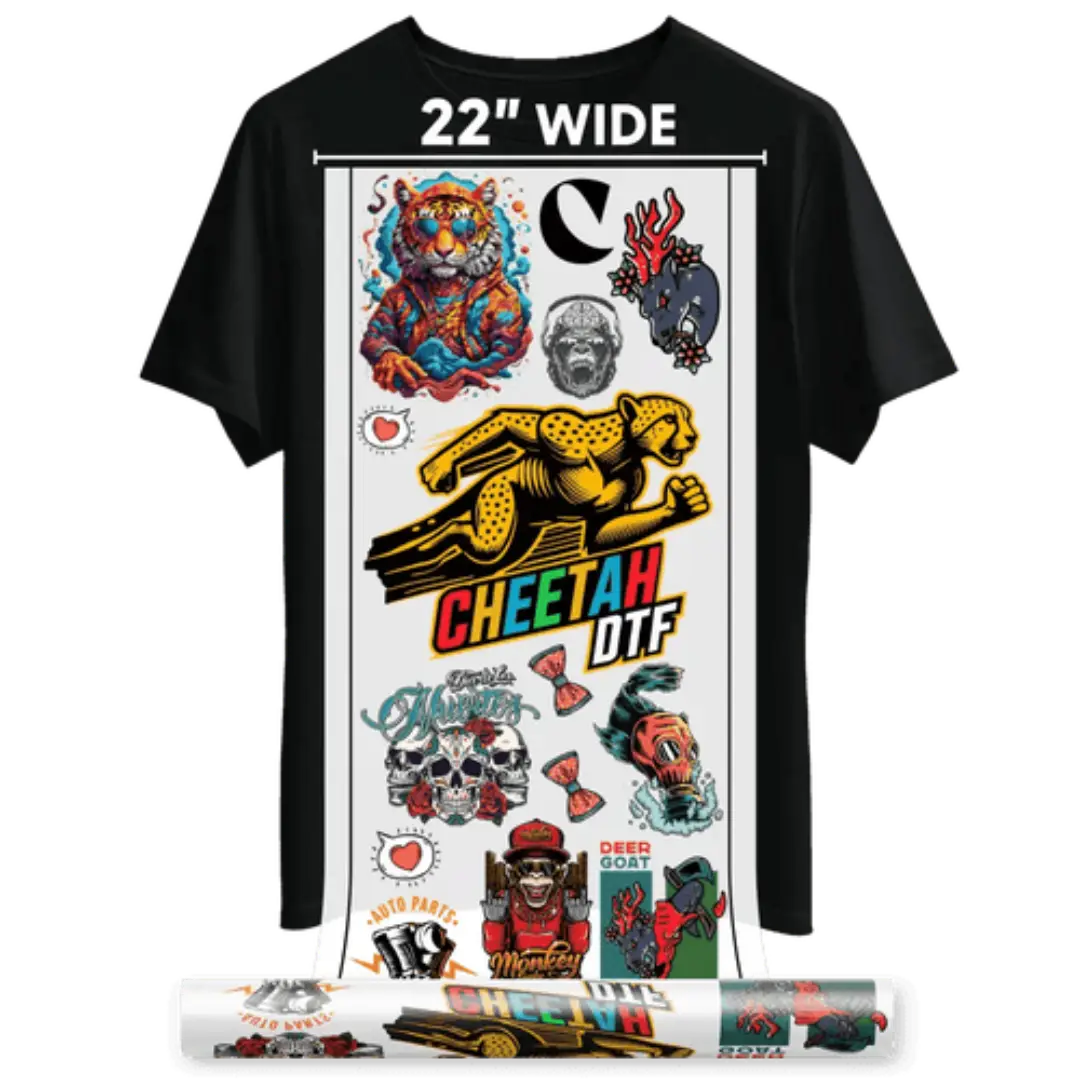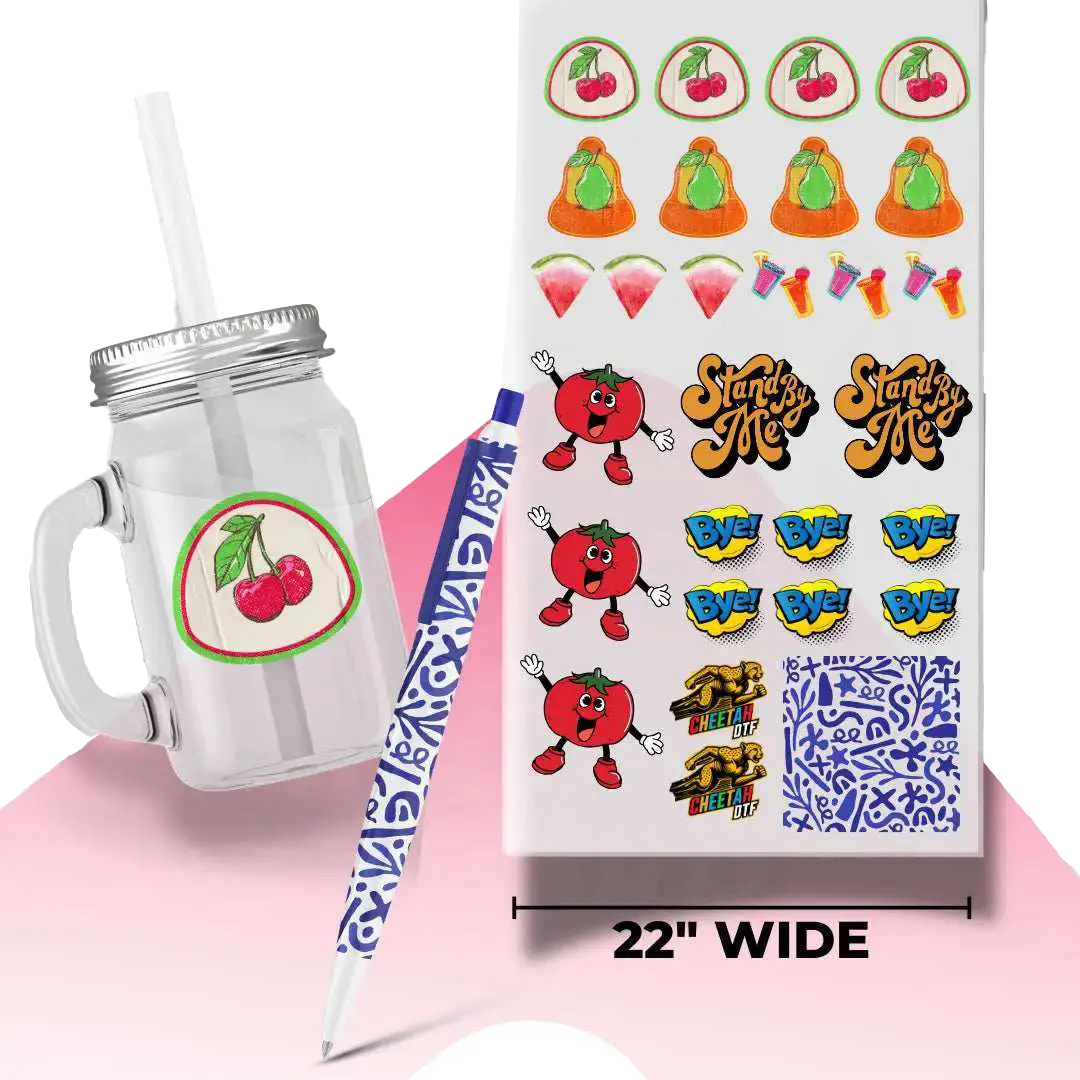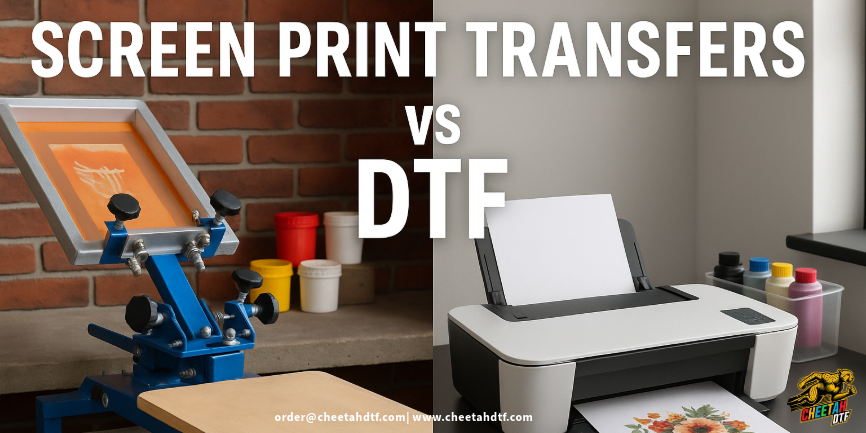Screen Print Transfers vs DTF: Choosing the Right Transfer Method
Understanding the key differences between screen printing and the new printing technique, direct-to-film (DTF) printing, is crucial for choosing the right transfer method. Both screen print transfers and DTF transfers have unique outcomes and applications in garment customization, including vibrant and durable prints.
Factors That Influence Your Choice
The choice between screen print and DTF transfers, especially in the DTF vs screen print context, impacts bulk orders, print quality, fabric compatibility, and setup costs, making it essential to consider cost effectiveness and setup time. DTF prints can last for years with proper care and have evolved to match the vibrancy and detail of screen printing, especially for intricate designs.
Benefits of Hands-On Experience
Experience with both methods can help compare results firsthand and determine the best printing method for specific needs. Understanding both DTF and screen print transfers, along with the various screen printing techniques, is crucial for optimal print outcomes, as each method offers unique benefits.
Our team is available to help you choose the right printing method for your next project.
Understanding Screen Print
Screen printing involves pushing ink through a woven mesh screen stencil onto fabric using traditional screen printing techniques, including the use of screen print transfers. Each color requires a separate screen, making it ideal for simple, multi-color designs with fewer colors.
The screen printing process uses plastisol ink and a special transfer paper with a heat press to attach designs onto garments, resulting in long-lasting prints. Screen printing is a highly versatile printing technique suitable for large volume orders and bulk production.
The Screen Printing Process
The screen printing process involves creating screens by stretching mesh over a frame and applying light-sensitive emulsion, followed by exposing the screen to light with the design. This is how screen printing works, as ink is pushed through the mesh screen onto fabric.
How Ink is Applied in Screen Printing
Ink is then pushed through the stencil onto fabric, color by color, using a squeegee, and cured with a dryer to ensure durability for multiple washes. Screen printed transfers use plastisol ink and a heat press to apply the design onto garments, while DTF uses adhesive powder differentiating them from other methods like Direct to Film (DTF) and heat transfer vinyl (HTV).
Tools and Performance of Screen Printing
Equipment includes screens, inks, and a press, making it a traditional method with extensive setup involved. Screen printing excels in producing vibrant colors and durable prints, especially when considering the screen print vs other methods, but may have limitations with intricate details and textured fabrics.
DTF Printing Overview
DTF printing is a new technique in which designs are printed directly onto a special film using advanced technology and DTF inks, resulting in durable and high-quality DTF prints.
How DTF Transfers Are Applied
The printed film is transferred onto fabric using a heat press and hot melt adhesive powder. The powder is sprinkled on the wet ink and cured to bond the design with the fabric, allowing for vibrant and detailed prints with unlimited colors.
Eco-Friendly and Cost-Effective Printing
DTF printing is a digital printing process that produces minimal waste and uses transfer paper, making it a cost-effective option for small quantities.
Ideal for Complex and Detailed Designs
DTF heat transfers are perfect for complex designs, intricate details, and photorealistic images. They can be printed on various materials, including dark fabrics.
Comparing Methods
Comparing different print methods, such as screen print transfers and DTF transfers, reveals differences in print durability, color reproduction, and fabric versatility, including the ability to print on synthetic materials and natural fibers.
DTF vs. Screen Print Transfers
DTF offers high versatility, excellent color reproduction, and a more straightforward setup, while screen printing provides high durability, cost-effectiveness, and vivid colors for large orders.
Choosing Based on Project Needs
The choice between these two methods depends on order quantity, design complexity, fabric type, and desired touch, with DTF suitable for small, detailed designs and screen printing favoring large, simple orders.
Final Thoughts on Print Methods
Both methods have their advantages and challenges, making it essential to consider the specific needs of each project and choose the most suitable printing method. Understanding the differences between these two methods is crucial for making informed decisions.
DTF Transfers
DTF transfers are a full-color decorating solution using water-soluble inks on a PET carrier with adhesive, allowing for detailed prints and vibrant colors, especially for complex, multi-colored designs.
Efficient Setup and Application
DTF transfers do not require weeding or burning screens, unlike screen printing, making them a more efficient option for small quantities and complex designs. They are the go-to choice for custom apparel printing due to their versatility and high-quality print resolution.
Ideal for Small Orders and Versatility
DTF transfers are ideal for low minimum orders and personalization, with the ability to produce long-lasting prints with proper care. DTF transfers can be used on various materials, including cotton, polyester, and blends, making them a versatile option for garment customization.
Print Durability
Both screen print transfers and DTF transfers can produce durable prints with proper care, including washing inside out and avoiding high heat, which is essential knowledge in the printing industry. Print durability depends on the quality of the transfer, the fabric used, and the application process, making it essential to follow best practices for each method.
Long-Lasting Results with Proper Care
DTF prints can last years with proper care, comparable to screen printing durability, and can withstand multiple washes without fading or cracking. The durability of screen print transfers and DTF prints makes them suitable for bulk orders and long-term use.
Lower Setup Costs and Enhanced Detail
DTF technology, unlike traditional methods, offers lower setup costs and minimal waste, making it accessible for new businesses. Additionally, DTF allows for detailed and vibrant designs on synthetic materials, showcasing its superiority in handling complex print requirements compared to older printing techniques.
Color Reproduction
DTF printing offers excellent color reproduction, with vibrant colors and smooth gradients, making it ideal for complex designs and photorealistic images. Screen printing also provides vivid colors, but may have limitations with intricate details and textured fabrics, making it more suitable for simple, multi-color designs.
Production Considerations for Color Complexity
Large orders with multiple colors can significantly increase production time due to the need for separate screens for each color in a design. The choice between DTF and screen print transfers depends on the specific color reproduction needs of each project, with DTF offering more flexibility and versatility.
High-Quality Color Output for Customization
Both methods can produce high-quality, vibrant prints with accurate color reproduction, making them suitable for garment customization and bulk orders.
Fabric Versatility
DTF printing offers remarkable versatility across a wide range of materials, including synthetics and stretchy fabrics, making it an ideal choice for businesses that need to print on various fabrics, especially when considering the screen print vs digital printing process excels in producing.
DTF prints vibrant and durable prints on intricate details and complex designs, ensuring high-quality results on cotton, polyester, and blends.
Limitations of Screen Printing on Fabric Types
In contrast, screen printing can be somewhat limited in fabric compatibility, which is important when comparing screen print transfers. While it excels at producing vibrant colors on natural fibers, it may struggle with dark or textured fabrics and intricate details. Screen printing is best suited for simpler, multi-color designs where fewer colors are involved.
Versatile Performance of DTF for Complex Designs
The ability of DTF printing to handle photorealistic images and intricate designs on various materials makes it a highly versatile option for garment customization, especially when it comes to fine detail whereas screen printing remains a strong contender for vibrant prints on natural fibers.
Production Speed and Efficiency
When it comes to production speed and efficiency in the printing industry, DTF printing stands out with its shorter setup time and ease of learning. This makes it an ideal choice for businesses that need to produce large quantities quickly. The digital nature of DTF printing allows for faster production, enabling businesses to meet tight deadlines and increase their productivity.
Screen Printing’s Labor-Intensive Process
On the other hand, screen printing works as a viable method for bulk orders, but it involves a more labor-intensive process compared to DTF printing, especially when printing on other materials. The extensive setup and cleanup required can slow down production, making it less efficient for quick turnarounds.
Cost-Effectiveness of DTF for Small Runs
DTF printing is also cost-effective for small runs or one-off prints, especially when evaluating the DTF vs screen print option, reducing waste and saving businesses money. Its efficiency and speed make it an attractive choice for businesses looking to produce high-quality prints on a variety of materials without the extensive setup time associated with traditional screen printing.
Cost Considerations
DTF printing tends to have lower setup costs, especially when considering the special transfer paper used, making it a more cost-effective option for small runs or one-off prints. This allows businesses to enter the market without a large upfront investment. The cost-effectiveness of DTF printing is further enhanced by its minimal setup time and labor costs, making it comparable to screen printing for large quantities.
Upfront Investment for Screen Printing
Screen printing, while still cost-effective for large orders, requires a significant upfront investment in equipment and supplies. In the screen print vs context, the extensive setup involved can also add to the overall cost, making it less ideal for small runs.
Eco-Friendly Benefits of DTF Printing
Additionally, DTF printing is more environmentally friendly than screen printing, particularly when utilizing a heat press for application. It uses water-based inks and produces minimal waste, aligning with the growing demand for sustainable printing practices. For businesses looking to produce high-quality prints on a budget, DTF printing offers a cost-effective and eco-friendly solution.
Scalability and Growth
Both DTF and screen printing are scalable methods, but they cater to different business needs and growth stages. Screen printing is ideal for large quantities and bulk orders, making it suitable for established businesses with high demand. Its ability to produce high-quality, long-lasting prints ensures that businesses can meet large-scale orders with consistent results.
DTF Printing for Startups and Small Businesses
On the other hand, DTF printing is more versatile and can handle small to medium-sized orders, making it perfect for startups, small businesses, or those with varying order quantities and offering unlimited colors.
Low Investment and Quick Adaptation
The lower setup costs and minimal waste associated with DTF printing make it an attractive option for businesses looking to scale up without significant upfront investment. This printing method’s ability to produce vibrant, detailed prints with minimal setup allows businesses to quickly adapt to changing market trends or customer preferences.
Adapting to Increased Demand
As a business grows, it may need to adapt its printing method to accommodate increasing demand. DTF printing’s flexibility and cost-effectiveness make it an excellent choice for scaling up, especially for businesses that need to quickly respond to market changes. Screen printing, with its high-quality, long-lasting prints, is better suited for businesses that prioritize durability and can accommodate the higher setup costs and longer production times.
Choose the Right Method to Fuel Your Growth
The choice between DTF and screen printing ultimately depends on the business’s specific needs, growth stage, and target market. By understanding the strengths and limitations of each method, businesses can make informed decisions about which printing technique to use, ensuring they can meet customer demand while maintaining profitability and competitiveness.


